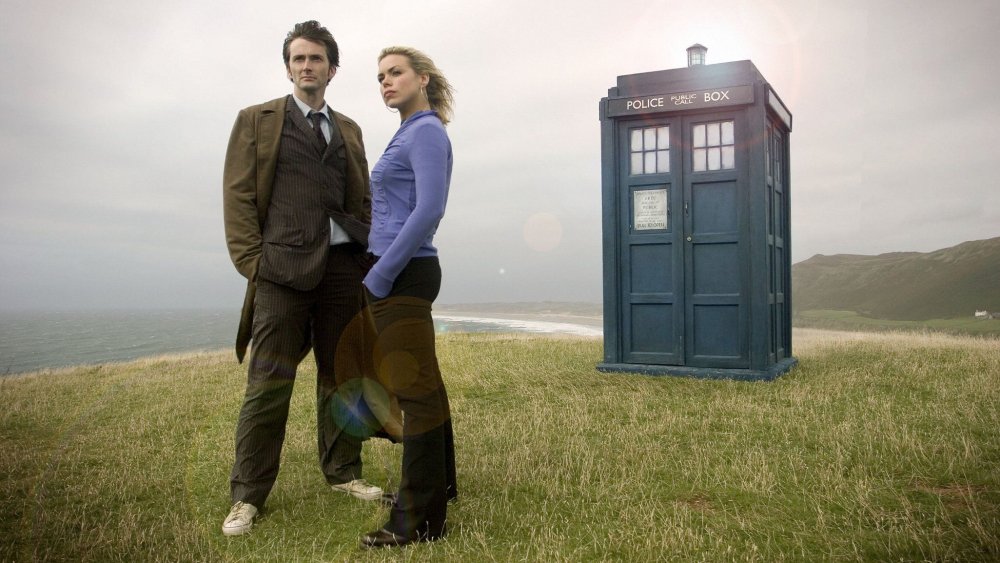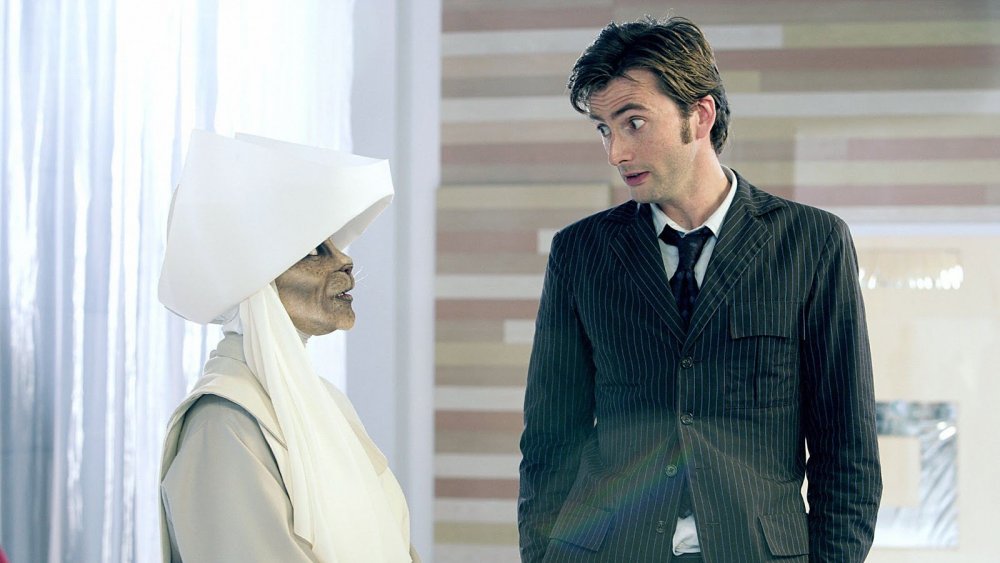The Doctor Who Regeneration Fact That Changes Everything
David Tennant is probably the most instantly recognizable actor who played the Doctor on the Doctor Who revival that started back in 2005. While Tennant's technical debut outing as the Time Lord was the first of the show's holiday specials, entitled "The Christmas Invasion," his first full season began with an episode called "New Earth," which featured mind possession, giant faces, and cat nuns. (Yes, nuns that are also cats — some of them have guns, too!)
Doctor Who's "New Earth" aired on April 15, 2006. On the following season, almost exactly one year later, the Doctor again visited New Earth during an episode entitled "Gridlock." By then, however, New Earth had become less idyllic, the Doctor had a new companion in Martha Jones (Freema Agyeman), and that long-time giant alien head in a jar, the Face of Boe, died. The only true constants were the Doctor and one specific cat nun named Novice Hame (Anna Hope).
Some 14 years later, Tennant, Hope, and former Who showrunner Russell T. Davies returned during the pandemic lockdown to tell "The Secret of Novice Hame," a kind of wrap-up to a proverbial cat nun trilogy. "The Secret of Novice Hame" is a story of how a beloved Doctor Who character dies, but it's also, as you might imagine from its title, about a secret — one that will forever change the way you view the Doctor's regeneration.
Novice Hame reveals that animals have taken on the Doctor name
The Doctor — with one, recent canonical exception — has always appeared as a humanoid man. Jodie Whittaker's Doctor notwithstanding, the only other suggestion we've ever had that the Doctor had been a woman in previous incarnations is by mention, during the Peter Capaldi era of Doctor Who. In 2008, Catherine Zeta-Jones was also rumored for Doctor Who, as reported by The Guardian. And in Doctor Who Unbound: "Exile," a non-canonical audio drama, Arabella Weir plays a version of the Doctor with bad indigestion who forgot she was the Doctor at all.
Basically, for all the changing Doctor Who has done since its inception in 1963, the Doctor has largely just been an alien dude in various silly suits. That's a big part of what "The Secret of Novice Hame" sets out to change. When the Doctor arrives to be Hame's final visitor at the end of her life, they appear as Tennant's 10th Doctor.
"I have heard so many stories about him over the years — his hundreds of faces and forms," says Hame. Then the cat nun drops a much bigger statement: "The men and women and animals who have taken that name. And yet, the one who comes for me is so familiar. This one is mine."
Men Doctors. Yup. Women Doctors? We did finally get there, yes. But animal Doctors? That idea is relatively new. In fact, the only immediate Doctor Who story that springs to mind suggesting the Doctor could be an animal specifically is the classic Sylvester McCoy-starring episode "Survival" from 1989, wherein we're introduced to a race of Cheetah People. In "Survival" the Doctor's nemesis the Master begins to turn into a Cheetah Person. The Doctor also gets some cat-like eyes at one point. But that's as far as it goes.
The other secret truth told
The modern series of Doctor Who has its own ways of suggesting the infinite possibilities of regeneration. On Christopher Eccleston's final episode of Doctor Who, "The Parting of the Ways," for example, he says this of regeneration: "I might have two heads, or no head. But it's a bit dodgy, this process. You never know what you're going to end up with."
Of course, if we're talking about "The Secret of Novice Hame," we have to also talk about the other way she changes everything. In addition to the reveal that the Doctor could be a lion, heron, mouse, owl, or even a spider, we also find out something new about New Earth. In the past, all we've really known is that the original Earth was eventually destroyed by the death of its sun, and then what remained of Earth's community was rebuilt across the cosmos, including on a nearly identical planet ultimately dubbed "New Earth."
In "The Secret of Novice Hame," Hame says that people thought of this new world as "a blessing" and as a place beyond the stars that called all the creatures of the Earth home. But then, she suggests an alternate theory: "What if this world is not a home — what if it's a trap? A long, slow, careful trap of infinite complexity?" Hame tells the Doctor that she did her research and is about to reveal the secret she discovered ... but then she dies. As her consciousness drifts away, she thinks that "the secret will have to wait, for other times, other cats, other Doctors."
With that, we are left to wonder what man, woman, or animal the Doctor might become next — and if they will be the Doctor to discover the secret trapped beneath the surface of New Earth.

